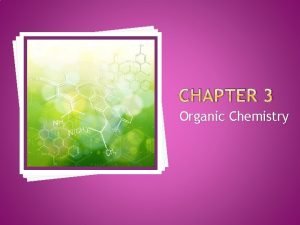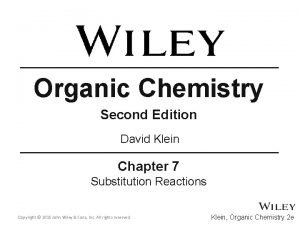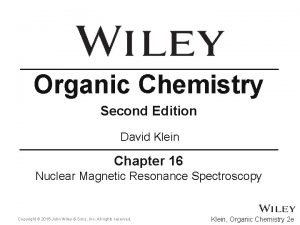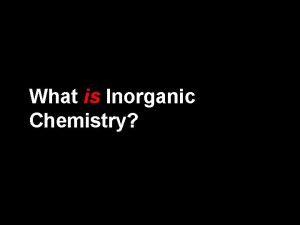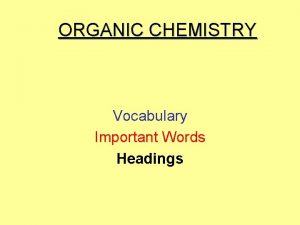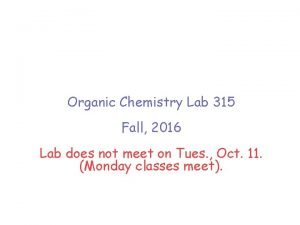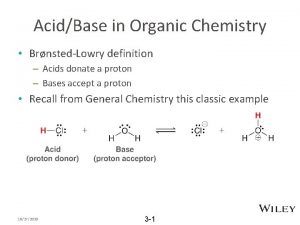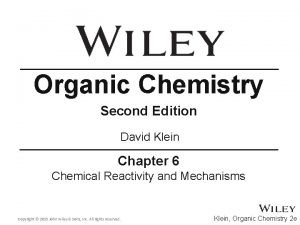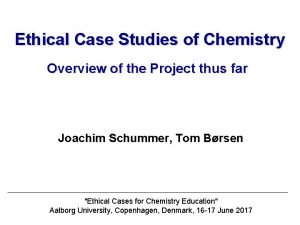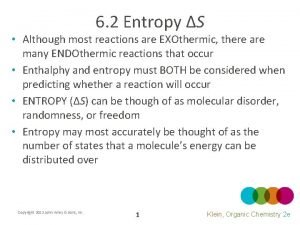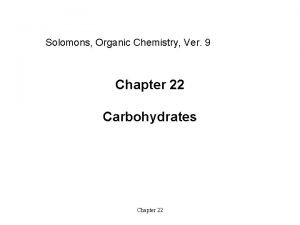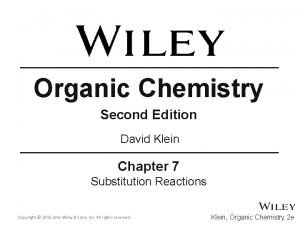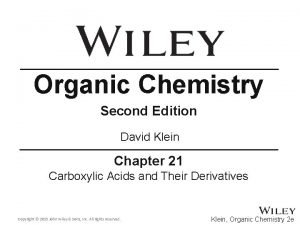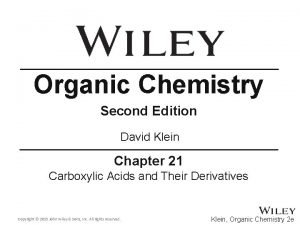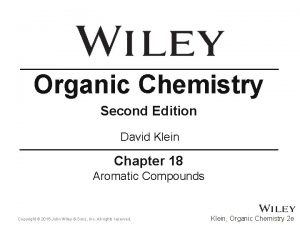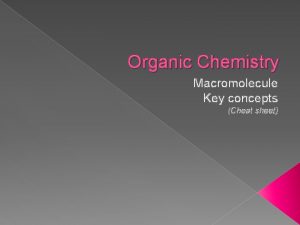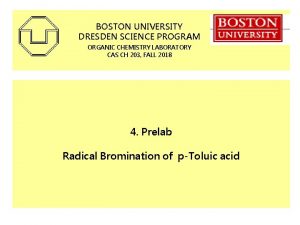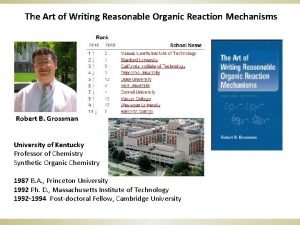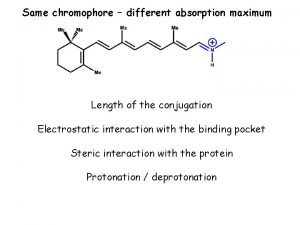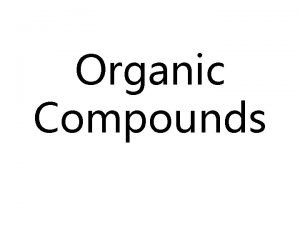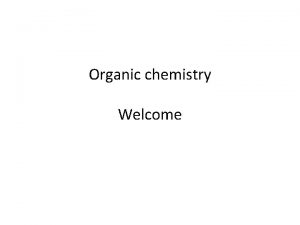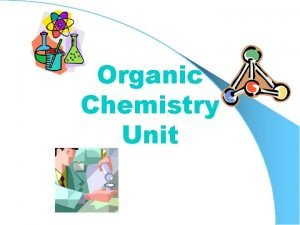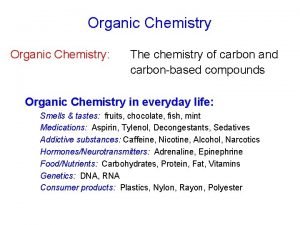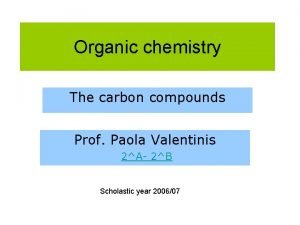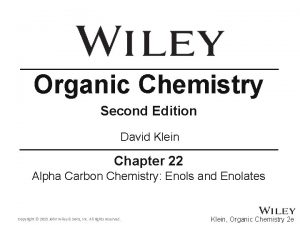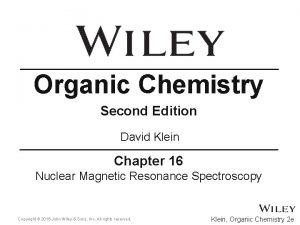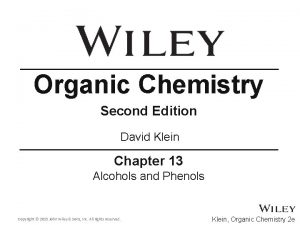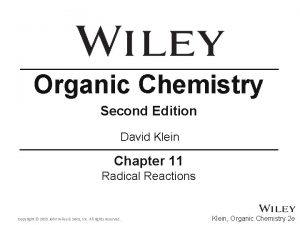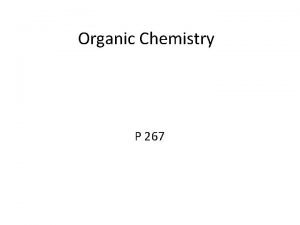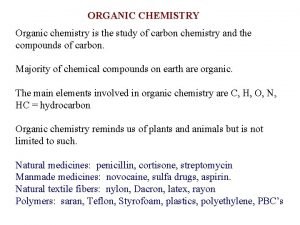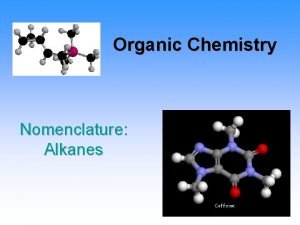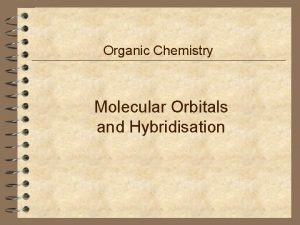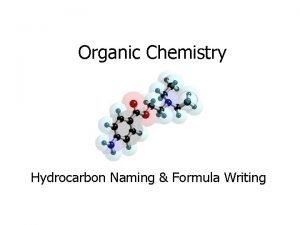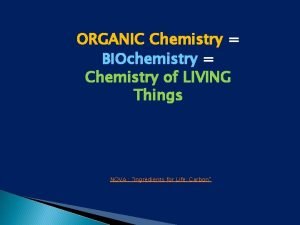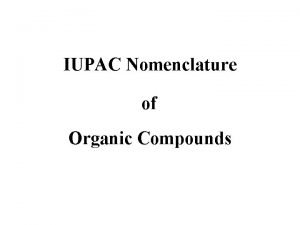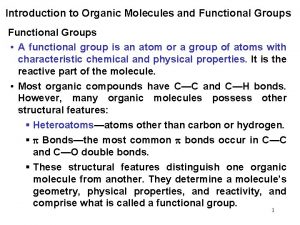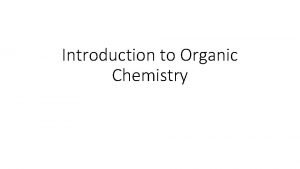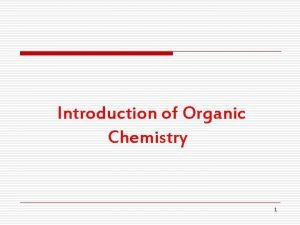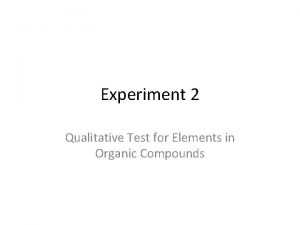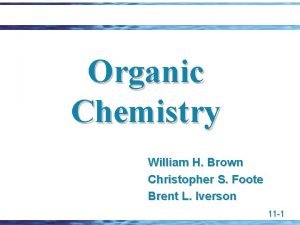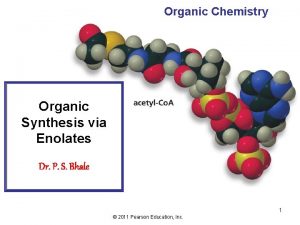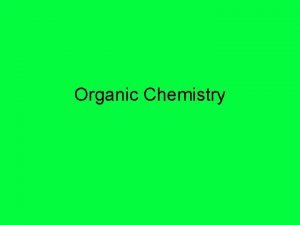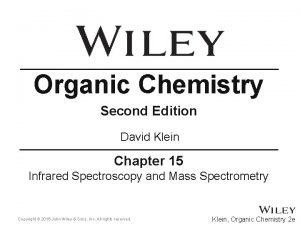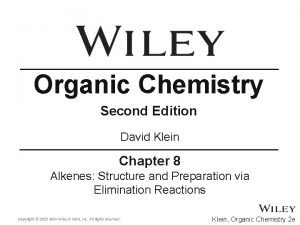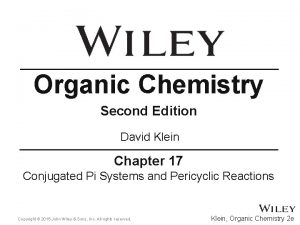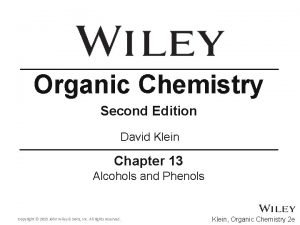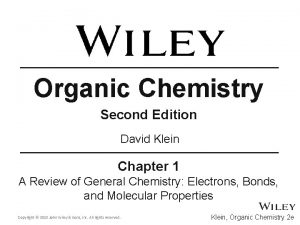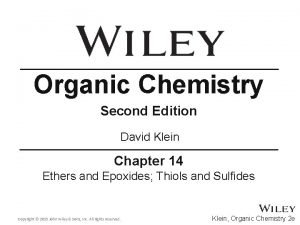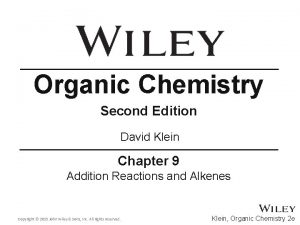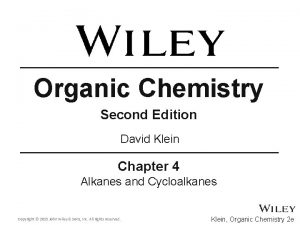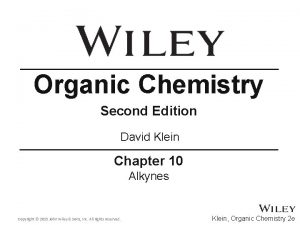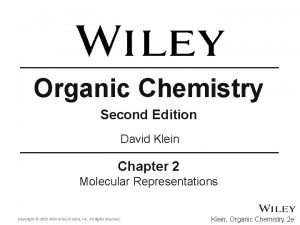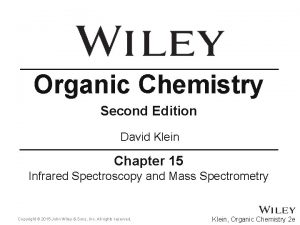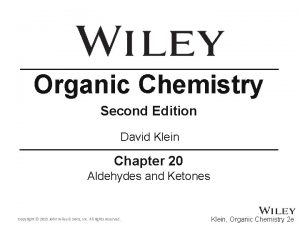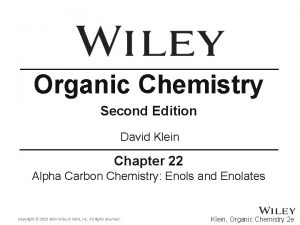Organic Chemistry Second Edition David Klein Chapter 21
































































































- Slides: 96

Organic Chemistry Second Edition David Klein Chapter 21 Carboxylic Acids and Their Derivatives Copyright © 2015 John Wiley & Sons, Inc. All rights reserved. Klein, Organic Chemistry 2 e

21. 14 Synthetic Strategies Copyright © 2015 John Wiley & Sons, Inc. All rights reserved. 21 -2 Klein, Organic Chemistry 2 e

21. 3 Structure and Properties of Carboxylic Acids • In water, the equilibrium generally favors the acid • p. Ka values mostly range between 4 and 5. What is p. Ka? Copyright © 2015 John Wiley & Sons, Inc. All rights reserved. 21 -3 Klein, Organic Chemistry 2 e

21. 3 Structure and Properties of Carboxylic Acids • How does the p. Ka value for a carboxylic acid compare to a strong acid like HCl or a very weak acid like ethanol? H-Cl p. Ka = -7 • How can induction and resonance be used to explain the acidity of a carboxylic acid? • Practice with conceptual checkpoints 21. 4 through 21. 7 Copyright © 2015 John Wiley & Sons, Inc. All rights reserved. 21 -4 Klein, Organic Chemistry 2 e

Copyright © 2015 John Wiley & Sons, Inc. All rights reserved. Klein, Organic Chemistry 2 e

21. 4 Preparation of Carboxylic Acids • In earlier chapters, we have already learned some methods to synthesize carboxylic acids Copyright © 2015 John Wiley & Sons, Inc. All rights reserved. 21 -6 Klein, Organic Chemistry 2 e

21. 4 Preparation of Carboxylic Acids • In earlier chapters, we have already learned some methods to synthesize carboxylic acids Copyright © 2015 John Wiley & Sons, Inc. All rights reserved. 21 -7 Klein, Organic Chemistry 2 e

21. 4 Preparation of Carboxylic Acids • Let’s examine two more ways to make carboxylic acids 1. The hydrolysis of a nitrile can produce a carboxylic acid – The mechanism will be discussed later – Carboxylic acids can be made from alkyl halides using a twostep process Copyright © 2015 John Wiley & Sons, Inc. All rights reserved. 21 -8 Klein, Organic Chemistry 2 e

21. 4 Preparation of Carboxylic Acids • Let’s examine two more ways to make carboxylic acids 2. Carboxylation of a Grignard reaction can be achieved using CO 2 -Mg. Br – The Grignard reagent and the H 3 O+ can not be added together. WHY? Copyright © 2015 John Wiley & Sons, Inc. All rights reserved. 21 -9 Klein, Organic Chemistry 2 e

21. 4 Preparation of Carboxylic Acids • This gives us a second method to convert an alkyl halide into a carboxylic acid • Practice with conceptual checkpoint 12. 10 Copyright © 2015 John Wiley & Sons, Inc. All rights reserved. 21 -10 Klein, Organic Chemistry 2 e

Copyright © 2015 John Wiley & Sons, Inc. All rights reserved. Klein, Organic Chemistry 2 e

21. 5 Reactions of Carboxylic Acids • Li. Al. H 4 is a strong reducing agent that can convert an acid to a primary alcohol • The LAH acts as a base first • Then, an aldehyde is produced Copyright © 2015 John Wiley & Sons, Inc. All rights reserved. 21 -12 Klein, Organic Chemistry 2 e

21. 5 Reactions of Carboxylic Acids • Li. Al. H 4 is a strong reducing agent that can convert an acid to a primary alcohol • The aldehyde is further reduced to the alcohol • Can the reduction be stopped at the aldehyde? Copyright © 2015 John Wiley & Sons, Inc. All rights reserved. 21 -13 Klein, Organic Chemistry 2 e

21. 5 Reactions of Carboxylic Acids • The more mild borane reagent can also be used to promote the reduction • Reduction with borane is selective compared to LAH reduction • Practice with conceptual checkpoint 21. 11 Copyright © 2015 John Wiley & Sons, Inc. All rights reserved. 21 -14 Klein, Organic Chemistry 2 e

Copyright © 2015 John Wiley & Sons, Inc. All rights reserved. Klein, Organic Chemistry 2 e

21. 6 Introduction to Carboxylic Acid Derivatives • When Z is a heteroatom, the compound is called a carboxylic acid derivative • Because it has the same oxidation state, a nitrile is also an acid derivative despite not having a carbonyl group Copyright © 2015 John Wiley & Sons, Inc. All rights reserved. 21 -16 Klein, Organic Chemistry 2 e

21. 7 Reactivity of Carboxylic Acid Derivatives • Carboxylic acid derivatives have electrophilic sites • Where? Copyright © 2015 John Wiley & Sons, Inc. All rights reserved. 21 -17 Klein, Organic Chemistry 2 e

21. 7 Reactivity of Carboxylic Acid Derivatives • Reactivity can be affected by – – Copyright © 2015 John Wiley & Sons, Inc. All rights reserved. 21 -18 Induction Resonance Sterics Quality of leaving group Klein, Organic Chemistry 2 e

21. 7 Reactivity of Carboxylic Acid Derivatives • Let’s examine the acid chloride – The electronegative chlorine enhances the electrophilic character of the carbonyl. HOW? – There are 3 resonance contributors to the acid chloride – The chlorine does not significantly donate electron density to the carbonyl. HOW does that affect its quality as an electrophile Copyright © 2015 John Wiley & Sons, Inc. All rights reserved. 21 -19 Klein, Organic Chemistry 2 e

21. 7 Reactivity of Carboxylic Acid Derivatives • Let’s examine the acid chloride – Describe how the presence of the chloride affects the sterics of the nucleophilic attack on the carbonyl – The chloride is a good leaving group, which also enhances its reactivity • Considering all of the factors involved, the acid chloride is quite reactive Copyright © 2015 John Wiley & Sons, Inc. All rights reserved. 21 -20 Klein, Organic Chemistry 2 e

21. 7 Reactivity of Carboxylic Acid Derivatives • Amides are the least reactive acid derivative • Examine the factors below to explain amide reactivity – Induction – Resonance – Sterics – Quality of leaving group Copyright © 2015 John Wiley & Sons, Inc. All rights reserved. 21 -21 Klein, Organic Chemistry 2 e

21. 7 Reactivity of Carboxylic Acid Derivatives • Aldehydes and ketones are also electrophilic, but they do not undergo substitution • WHY? Consider induction, resonance, sterics, and quality of leaving group Copyright © 2015 John Wiley & Sons, Inc. All rights reserved. 21 -22 Klein, Organic Chemistry 2 e

21. 7 Reactivity of Carboxylic Acid Derivatives • Nucleophilic acyl substitution is a two-step process • Because C=O double bonds are quite stable, the “loss of leaving group” step should occur if a leaving group is present • – H and –R do not qualify as leaving groups. WHY? Copyright © 2015 John Wiley & Sons, Inc. All rights reserved. 21 -23 Klein, Organic Chemistry 2 e

21. 7 Reactivity of Carboxylic Acid Derivatives • Let’s analyze a specific example • The highest quality leaving group leaves the tetrahedral intermediate Copyright © 2015 John Wiley & Sons, Inc. All rights reserved. 21 -24 Klein, Organic Chemistry 2 e

21. 7 Reactivity of Carboxylic Acid Derivatives • Do NOT draw the acyl substitution with an SN 2 mechanism • Sometimes a proton transfer will be necessary in the mechanism – Under acidic conditions, (–) charges rarely form. WHY? – Under basic conditions, (+) charges rarely form. WHY? Copyright © 2015 John Wiley & Sons, Inc. All rights reserved. 21 -25 Klein, Organic Chemistry 2 e

21. 7 Reactivity of Carboxylic Acid Derivatives • Neutral nucleophiles are generally less reactive, but they can still react if given enough time • An intermediate with both (+) and (-) charge forms • Intermediates with two (+) or two (-) charges are very unlikely to form. WHY? Copyright © 2015 John Wiley & Sons, Inc. All rights reserved. 21 -26 Klein, Organic Chemistry 2 e

21. 7 Reactivity of Carboxylic Acid Derivatives • Depending on reaction conditions, up to 3 proton transfers may be necessary in the mechanism • Draw a complete mechanism for the reaction below • Will the reaction be reversible? • What conditions could be employed to favor products? • Practice with Skill. Builder 21. 1 Copyright © 2015 John Wiley & Sons, Inc. All rights reserved. 21 -27 Klein, Organic Chemistry 2 e

Copyright © 2015 John Wiley & Sons, Inc. All rights reserved. Klein, Organic Chemistry 2 e

Copyright © 2015 John Wiley & Sons, Inc. All rights reserved. Klein, Organic Chemistry 2 e

21. 7 Reactivity of Carboxylic Acid Derivatives • Give necessary reaction conditions and a complete mechanism for the reaction below • Describe how conditions could be modified to favor the products as much as possible Copyright © 2015 John Wiley & Sons, Inc. All rights reserved. 21 -30 Klein, Organic Chemistry 2 e

21. 8 Preparation and Reaction of Acid Chlorides • Acid chlorides have great synthetic utility. WHY? • An acid chloride may form when an acid is treated with SOCl 2 Copyright © 2015 John Wiley & Sons, Inc. All rights reserved. 21 -31 Klein, Organic Chemistry 2 e

21. 8 Preparation and Reaction of Acid Chlorides Copyright © 2015 John Wiley & Sons, Inc. All rights reserved. 21 -32 Klein, Organic Chemistry 2 e

21. 8 Preparation and Reaction of Acid Chlorides • The mechanism is more favored in the presence of a non-nucleophilic base like pyridine. WHY? Copyright © 2015 John Wiley & Sons, Inc. All rights reserved. 21 -33 Klein, Organic Chemistry 2 e

21. 8 Preparation and Reaction of Acid Chlorides: HYDROLYSIS • To avoid an acid chloride being converted into an acid, it must be protected from moisture Copyright © 2015 John Wiley & Sons, Inc. All rights reserved. 21 -34 Klein, Organic Chemistry 2 e

21. 8 Preparation and Reaction of Acid Chlorides: ALCOHOLYSIS • Often acid chlorides are used to synthesize esters • Give a complete mechanism showing how pyridine acts as a base in the mechanism Copyright © 2015 John Wiley & Sons, Inc. All rights reserved. 21 -35 Klein, Organic Chemistry 2 e

21. 8 Preparation and Reaction of Acid Chlorides: AMINOLYSIS • Often acid chlorides are used to synthesize amides • Give a complete mechanism showing WHY two equivalents are used Copyright © 2015 John Wiley & Sons, Inc. All rights reserved. 21 -36 Klein, Organic Chemistry 2 e

Copyright © 2015 John Wiley & Sons, Inc. All rights reserved. Klein, Organic Chemistry 2 e

21. 8 Preparation and Reaction of Acid Chlorides • Acid chlorides can also be reduced using LAH Copyright © 2015 John Wiley & Sons, Inc. All rights reserved. 21 -38 Klein, Organic Chemistry 2 e

21. 8 Preparation and Reaction of Acid Chlorides • Acid chlorides can also be reduced using LAH • The acid must be added after the LAH has given adequate time to react completely Copyright © 2015 John Wiley & Sons, Inc. All rights reserved. 21 -39 Klein, Organic Chemistry 2 e

21. 8 Preparation and Reaction of Acid Chlorides • To stop the aldehyde from being reduced to the alcohol, a bulky reducing agent can be used • HOW does lithium tri(t-butoxy) aluminum hydride allow the reduction to be stopped at the aldehyde? Copyright © 2015 John Wiley & Sons, Inc. All rights reserved. 21 -40 Klein, Organic Chemistry 2 e

21. 8 Preparation and Reaction of Acid Chlorides • Acid chlorides can also be attacked by Grignard nucleophiles Copyright © 2015 John Wiley & Sons, Inc. All rights reserved. 21 -41 Klein, Organic Chemistry 2 e

21. 8 Preparation and Reaction of Acid Chlorides • Two equivalents of the Grignard yield a 3° alcohol Copyright © 2015 John Wiley & Sons, Inc. All rights reserved. 21 -42 Klein, Organic Chemistry 2 e

21. 8 Preparation and Reaction of Acid Chlorides • The Gilman reagent is another nucleophilic organometallic reagent that reacts readily with acid chlorides • The C-Cu bond is less ionic than the C-Mg bond. WHY? Gilman reagent R • How does the ionic character of the bond affect the reactivity of the organometallic reagent? Copyright © 2015 John Wiley & Sons, Inc. All rights reserved. 21 -43 Klein, Organic Chemistry 2 e

21. 8 Preparation and Reaction of Acid Chlorides • Figure 21. 9 illustrates the reactions of acid chlorides we discussed • Practice with conceptual checkpoints 21. 18 through 21. 20 Copyright © 2015 John Wiley & Sons, Inc. All rights reserved. 21 -44 Klein, Organic Chemistry 2 e

Copyright © 2015 John Wiley & Sons, Inc. All rights reserved. Klein, Organic Chemistry 2 e

21. 8 Preparation and Reaction of Acid Chlorides • Fill in necessary reagents for the reactions below Copyright © 2015 John Wiley & Sons, Inc. All rights reserved. 21 -46 Klein, Organic Chemistry 2 e

21. 9 Preparation and Reactions of Acid Anhydrides • Acetic anhydride can be synthesized by heating 2 moles of acetic acid • Why is so much heat needed to drive the equilibrium forward? • This process doesn’t work for most other acids, because their structures can not withstand such high temperatures Copyright © 2015 John Wiley & Sons, Inc. All rights reserved. 21 -47 Klein, Organic Chemistry 2 e

21. 9 Preparation and Reactions of Acid Anhydrides • A more practical synthesis occurs when an acid chloride is treated with a carboxylate • The –R groups attached to the anhydride do not have to be equivalent Copyright © 2015 John Wiley & Sons, Inc. All rights reserved. 21 -48 Klein, Organic Chemistry 2 e

21. 9 Preparation and Reactions of Acid Anhydrides • Given that they both contain quality leaving groups, how do you think the reactions of anhydrides compare to the reactions we already saw for chlorides? • Which has a better leaving group? WHY? Copyright © 2015 John Wiley & Sons, Inc. All rights reserved. 21 -49 Klein, Organic Chemistry 2 e

21. 9 Preparation and Reactions of Acid Anhydrides • Figure 21. 10 shows how anhydrides can undergo many reactions analogous to those of acid chlorides Copyright © 2015 John Wiley & Sons, Inc. All rights reserved. 21 -50 Klein, Organic Chemistry 2 e

21. 9 Preparation and Reactions of Acid Anhydrides • Acetic anhydride is often used to acetylate an amine or an alcohol Copyright © 2015 John Wiley & Sons, Inc. All rights reserved. 21 -51 Klein, Organic Chemistry 2 e

21. 9 Preparation and Reactions of Acid Anhydrides • Practice with conceptual checkpoint 21. 21 Copyright © 2015 John Wiley & Sons, Inc. All rights reserved. 21 -52 Klein, Organic Chemistry 2 e

Copyright © 2015 John Wiley & Sons, Inc. All rights reserved. Klein, Organic Chemistry 2 e

Copyright © 2015 John Wiley & Sons, Inc. All rights reserved. Klein, Organic Chemistry 2 e

Copyright © 2015 John Wiley & Sons, Inc. All rights reserved. Klein, Organic Chemistry 2 e

21. 10 Preparation of Esters • Fischer esterification combines a carboxylic acid an alcohol using an acid catalyst Copyright © 2015 John Wiley & Sons, Inc. All rights reserved. 21 -56 Klein, Organic Chemistry 2 e

21. 10 Preparation of Esters • Fischer esterification mechanism continued • Each step is an equilibrium • Under acidic conditions, (-) charges are avoided Copyright © 2015 John Wiley & Sons, Inc. All rights reserved. 21 -57 Klein, Organic Chemistry 2 e

21. 10 Preparation of Esters • The overall Fischer esterification reaction is an equilibrium process • How might you use Le Chatelier’s principle to favor products? • How might you use Le Chatelier’s principle to favor reactants? • Is there an entropy difference that might be exploited? Copyright © 2015 John Wiley & Sons, Inc. All rights reserved. 21 -58 Klein, Organic Chemistry 2 e

21. 10 Preparation of Esters • Esters can also be prepared by treating an acid chloride with an alcohol – see section 21. 8 • Practice with conceptual checkpoint 21. 22 and 21. 23 Copyright © 2015 John Wiley & Sons, Inc. All rights reserved. 21 -59 Klein, Organic Chemistry 2 e

Copyright © 2015 John Wiley & Sons, Inc. All rights reserved. Klein, Organic Chemistry 2 e

Copyright © 2015 John Wiley & Sons, Inc. All rights reserved. Klein, Organic Chemistry 2 e

21. 11 Reactions of Esters • Esters can undergo hydrolysis in the presence of aqueous hydroxide (saponification) • Predict the last steps in the mechanism • To produce a carboxylic acid, H 3 O+ must be added at the end. WHY? Copyright © 2015 John Wiley & Sons, Inc. All rights reserved. 21 -62 Klein, Organic Chemistry 2 e

21. 11 Reactions of Esters • Esters can also undergo aminolysis • The overall equilibrium favors the amide formation – Because of enthalpy or entropy? • The synthetic utility is limited, because the process is slow and because there are more efficient ways to synthesize amides Copyright © 2015 John Wiley & Sons, Inc. All rights reserved. 21 -63 Klein, Organic Chemistry 2 e

21. 11 Reactions of Esters • Esters can be reduced using reagents such as Li. Al. H 4 • Two equivalents of reducing agent are required • Two alcohols are produced • Draw a reasonable mechanism Copyright © 2015 John Wiley & Sons, Inc. All rights reserved. 21 -64 Klein, Organic Chemistry 2 e

21. 11 Reactions of Esters • Li. Al. H 4 is a strong reducing agent, so a full reduction beyond the aldehyde to the alcohol can not be avoided • When performed at low temperature, reduction with DIBAH yields an aldehyde. HOW? Copyright © 2015 John Wiley & Sons, Inc. All rights reserved. 21 -65 Klein, Organic Chemistry 2 e

21. 11 Reactions of Esters • Esters can also react with LAH • Two moles can be used to make a tertiary alcohol Copyright © 2015 John Wiley & Sons, Inc. All rights reserved. 21 -66 Klein, Organic Chemistry 2 e

21. 11 Reactions of Esters • Esters can also react with Grignard reagents • Two moles can be used to make a tertiary alcohol • Practice with conceptual checkpoint 21. 24 and 21. 25 Copyright © 2015 John Wiley & Sons, Inc. All rights reserved. 21 -67 Klein, Organic Chemistry 2 e

Copyright © 2015 John Wiley & Sons, Inc. All rights reserved. Klein, Organic Chemistry 2 e

21. 11 Reactions of Esters • Give necessary reagents for the conversions below Copyright © 2015 John Wiley & Sons, Inc. All rights reserved. 21 -69 Klein, Organic Chemistry 2 e

21. 12 Preparation and Reactions of Amides • Nylon is a polyamide • Polyester is made similarly. HOW? Copyright © 2015 John Wiley & Sons, Inc. All rights reserved. 21 -70 Klein, Organic Chemistry 2 e

21. 12 Preparation and Reactions of Amides • Amides can be hydrolyzed with H 3 O+, but the process is slow and requires high temperature • The mechanism is very similar to that for the hydrolysis of an ester • Show a complete mechanism • WHY is the process generally slow? Copyright © 2015 John Wiley & Sons, Inc. All rights reserved. 21 -71 Klein, Organic Chemistry 2 e

21. 12 Preparation and Reactions of Amides • Amides can be hydrolyzed with H 3 O+, but the process is slow and requires high temperature • Should the equilibrium favor reactants or products? WHY? • Where does the NH 4+ come from? • Amide hydrolysis can also be promoted with Na. OH, although the process is very slow Copyright © 2015 John Wiley & Sons, Inc. All rights reserved. 21 -72 Klein, Organic Chemistry 2 e

21. 12 Preparation and Reactions of Amides • Li. Al. H 4 can reduce an amide to an amine • The mechanism is quite different from the others we have seen in this chapter • When the H- attacks, which is the best leaving group? Copyright © 2015 John Wiley & Sons, Inc. All rights reserved. 21 -73 Klein, Organic Chemistry 2 e

21. 12 Preparation and Reactions of Amides • The iminium is reduced with a second equivalent of hydride • Practice with conceptual checkpoints 21. 26 through 21. 28 Copyright © 2015 John Wiley & Sons, Inc. All rights reserved. 21 -74 Klein, Organic Chemistry 2 e

Copyright © 2015 John Wiley & Sons, Inc. All rights reserved. Klein, Organic Chemistry 2 e

21. 13 Preparation and Reactions of Nitriles • When a 1° or 2° alkyl halide is treated with a cyanide ion, the CN- acts as a nucleophile in an SN 2 reaction • Nitriles can also be made by dehydrating an amide using a variety of reagents including SOCl 2 Copyright © 2015 John Wiley & Sons, Inc. All rights reserved. 21 -76 Klein, Organic Chemistry 2 e

21. 13 Preparation and Reactions of Nitriles • What base might you use? Copyright © 2015 John Wiley & Sons, Inc. All rights reserved. 21 -77 Klein, Organic Chemistry 2 e

21. 13 Preparation and Reactions of Nitriles • An aqueous strong acid solution can be used to hydrolyze a nitrile • In the mechanism, the nitrogen is protonated multiple times and water acts as a nucleophile • Draw a complete mechanism Copyright © 2015 John Wiley & Sons, Inc. All rights reserved. 21 -78 Klein, Organic Chemistry 2 e

21. 13 Preparation and Reactions of Nitriles • Basic hydrolysis of a nitrile can also be achieved • Which group in the reaction acts as a nucleophile? • Which group acts to protonate the nitrogen? • Draw a complete mechanism Copyright © 2015 John Wiley & Sons, Inc. All rights reserved. 21 -79 Klein, Organic Chemistry 2 e

21. 13 Preparation and Reactions of Nitriles • Nitriles can also react with Grignards • After the nitrile is consumed, H 3 O+ is added to form an imine, which can be hydrolyzed with excess H 3 O+ (aq) to form a ketone. SHOW a mechanism Copyright © 2015 John Wiley & Sons, Inc. All rights reserved. 21 -80 Klein, Organic Chemistry 2 e

21. 13 Preparation and Reactions of Nitriles • Similar to how carboxylic acids can be converted to alcohols using LAH (section 21. 5), nitriles can be converted to amines • Practice with conceptual checkpoints 21. 29 through 21. 31 Copyright © 2015 John Wiley & Sons, Inc. All rights reserved. 21 -81 Klein, Organic Chemistry 2 e

21. 14 Synthetic Strategies • When designing a synthesis, there are two general considerations that we make 1. Is there a change in the carbon skeleton? 2. Is there a change in functional groups? • We have learned many new functional group transformations in this chapter – see next slide • Practice with Skill. Builder 21. 2 Copyright © 2015 John Wiley & Sons, Inc. All rights reserved. 21 -82 Klein, Organic Chemistry 2 e

21. 14 Synthetic Strategies Copyright © 2015 John Wiley & Sons, Inc. All rights reserved. 21 -83 Klein, Organic Chemistry 2 e

21. 14 Synthetic Strategies • Give necessary reagents for the conversion below. Multiple steps will be necessary Copyright © 2015 John Wiley & Sons, Inc. All rights reserved. 21 -84 Klein, Organic Chemistry 2 e

21. 14 Synthetic Strategies • There are 2 categories of bond-forming reactions Copyright © 2015 John Wiley & Sons, Inc. All rights reserved. 21 -85 Klein, Organic Chemistry 2 e

21. 14 Synthetic Strategies • When forming new carbon-carbon bonds, it is critical to install functional groups in the proper location • Give necessary reagents for the conversion below. More than one step will be necessary • Practice with Skill. Builder 21. 3 Copyright © 2015 John Wiley & Sons, Inc. All rights reserved. 21 -86 Klein, Organic Chemistry 2 e

Copyright © 2015 John Wiley & Sons, Inc. All rights reserved. Klein, Organic Chemistry 2 e

Copyright © 2015 John Wiley & Sons, Inc. All rights reserved. Klein, Organic Chemistry 2 e

Copyright © 2015 John Wiley & Sons, Inc. All rights reserved. Klein, Organic Chemistry 2 e

Additional Practice Problems • Give an appropriate name for the compound below Copyright © 2015 John Wiley & Sons, Inc. All rights reserved. 21 -90 Klein, Organic Chemistry 2 e

Additional Practice Problems • Rank the following molecules by increasing p. Ka values. Copyright © 2015 John Wiley & Sons, Inc. All rights reserved. 21 -91 Klein, Organic Chemistry 2 e

Additional Practice Problems • Predict the products for the reactions below. Copyright © 2015 John Wiley & Sons, Inc. All rights reserved. 21 -92 Klein, Organic Chemistry 2 e

Additional Practice Problems • Give an appropriate name for the amide below Copyright © 2015 John Wiley & Sons, Inc. All rights reserved. 21 -93 Klein, Organic Chemistry 2 e

Additional Practice Problems • Using induction, sterics, and resonance, explain why acid halides are especially electrophilic from a kinetic perspective. Copyright © 2015 John Wiley & Sons, Inc. All rights reserved. 21 -94 Klein, Organic Chemistry 2 e

Additional Practice Problems • Using the quality of the leaving group, explain why acid halides are especially reactive from a thermodynamic perspective. Copyright © 2015 John Wiley & Sons, Inc. All rights reserved. 21 -95 Klein, Organic Chemistry 2 e

Additional Practice Problems • Give reagents necessary for the synthesis below where all carbon atoms in the product come from a molecule of the reactant Copyright © 2015 John Wiley & Sons, Inc. All rights reserved. 21 -96 Klein, Organic Chemistry 2 e
 Organic chemistry second edition david klein
Organic chemistry second edition david klein Rearranged most stable carbocation is
Rearranged most stable carbocation is Nomenclature of ethers
Nomenclature of ethers Organic chemistry (3rd) edition chapter 1 problem 20s
Organic chemistry (3rd) edition chapter 1 problem 20s Organic chemistry third edition david klein
Organic chemistry third edition david klein Klein organic chemistry 2nd edition
Klein organic chemistry 2nd edition Klein organic chemistry 2nd edition
Klein organic chemistry 2nd edition Pericyclic
Pericyclic Organic chemistry (3rd) edition chapter 2 problem 17s
Organic chemistry (3rd) edition chapter 2 problem 17s Ib organic chemistry
Ib organic chemistry Organic vs inorganic chemistry
Organic vs inorganic chemistry Importance of organic compounds
Importance of organic compounds Chapter 22 review organic chemistry section 1 answers
Chapter 22 review organic chemistry section 1 answers Organic chemistry chapter 9
Organic chemistry chapter 9 Chapter 7 organic chemistry
Chapter 7 organic chemistry This name
This name Analytical chemistry chapter 1
Analytical chemistry chapter 1 David klein
David klein Organic chemistry
Organic chemistry Numbering carbon chains
Numbering carbon chains Canola oil
Canola oil Ester organic chemistry
Ester organic chemistry Alkene formula
Alkene formula Ee organic chemistry
Ee organic chemistry Leveling effect organic chemistry
Leveling effect organic chemistry What is the leveling effect organic chemistry
What is the leveling effect organic chemistry Priority of functional groups in iupac nomenclature
Priority of functional groups in iupac nomenclature Organic chemistry lab report sample
Organic chemistry lab report sample Organic chemistry conversion chart
Organic chemistry conversion chart Grade 10 organic chemistry
Grade 10 organic chemistry Cyclo organic chemistry
Cyclo organic chemistry Kiliani fischer synthesis
Kiliani fischer synthesis Meth eth prop
Meth eth prop Fractional distillation of petroleum
Fractional distillation of petroleum Eth meth prop but pent
Eth meth prop but pent Organic chemistry myanmar
Organic chemistry myanmar Ch3co+ electrophile name
Ch3co+ electrophile name M+1 peak
M+1 peak Hono organic chemistry
Hono organic chemistry Saytzeff’s rule
Saytzeff’s rule Topic 11 organic chemistry
Topic 11 organic chemistry Organic chemistry reaction pathways
Organic chemistry reaction pathways Organic chemistry nomenclature
Organic chemistry nomenclature What is organic chemistry like
What is organic chemistry like Is ch4o organic or inorganic
Is ch4o organic or inorganic Organic chemistry vocabulary
Organic chemistry vocabulary Organic chemistry laboratory ch 2540 manual
Organic chemistry laboratory ch 2540 manual A level chemistry ocr organic synthesis
A level chemistry ocr organic synthesis Difference between fats and oils in organic chemistry
Difference between fats and oils in organic chemistry Ario acidity
Ario acidity Calculate percentage yield
Calculate percentage yield Polarimetry organic chemistry
Polarimetry organic chemistry Organic chemistry
Organic chemistry Hammonds postulate
Hammonds postulate Organic chemistry case studies
Organic chemistry case studies Hammond's postulate organic chemistry
Hammond's postulate organic chemistry Structure and bonding in organic chemistry
Structure and bonding in organic chemistry Carbohydrates organic chemistry
Carbohydrates organic chemistry Organic chemistry
Organic chemistry Organic chemistry
Organic chemistry Organic chemistry
Organic chemistry Organic chemistry
Organic chemistry Organic chemistry cheat sheet
Organic chemistry cheat sheet Chemistry mind map
Chemistry mind map Organic chemistry stuart warren
Organic chemistry stuart warren Bu organic chemistry
Bu organic chemistry Organic chemistry
Organic chemistry Rhodopsin cgmp
Rhodopsin cgmp Organic chemistry
Organic chemistry Cyclopentane condensed structural formula
Cyclopentane condensed structural formula Which allotrope of carbon feels greasy and crumbles easily?
Which allotrope of carbon feels greasy and crumbles easily? C6h14 structural isomers
C6h14 structural isomers Organic chemistry
Organic chemistry Wiley
Wiley Organic chemistry
Organic chemistry Chemistry
Chemistry Nbs
Nbs Organic chemistry
Organic chemistry Butan 2 on
Butan 2 on Organic chemistry
Organic chemistry Organic chemistry class 11 notes
Organic chemistry class 11 notes Organic chemistry
Organic chemistry Cho
Cho Danswer
Danswer Resonance hybrid
Resonance hybrid Iupac
Iupac Polar functional groups
Polar functional groups Organic chemistry
Organic chemistry Chemistry meth eth prop but
Chemistry meth eth prop but What is beilstein test
What is beilstein test Organic chemistry william h brown
Organic chemistry william h brown Organic synthesis via enolates
Organic synthesis via enolates Organic chemistry
Organic chemistry Brooklyn college organic chemistry
Brooklyn college organic chemistry 186 282 miles per second into meters per second
186 282 miles per second into meters per second Advanced word power second edition answers
Advanced word power second edition answers Accounting principles second canadian edition
Accounting principles second canadian edition















